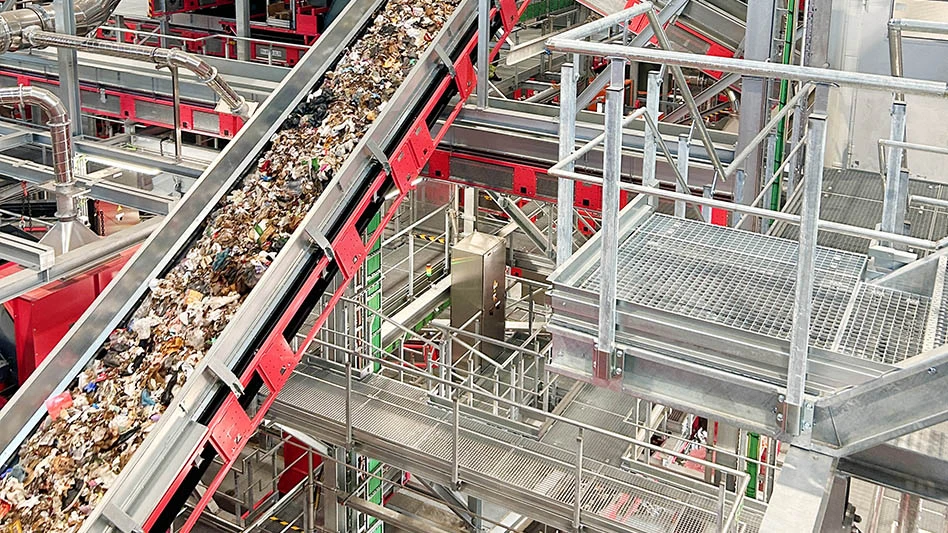
For centuries, solid waste has been generated from residential, industrial and commercial activities in communities across the globe. To keep cities and towns clean as well as protect the environment and people’s health, planning a successful municipal solid waste program is important for driving sustainability.
Like many communities around the world, Sioux Falls, South Dakota, has taken proactive measures to develop a sustainable municipal solid waste program. With the city’s Sioux Falls Regional Sanitary Landfill receiving more than 200,000 tons of municipal solid waste and more than 90,000 tons of construction and debris annually, leaders have taken a collaborative approach to improving the landfill’s airspace utilization.
Sioux Falls Regional Sanitary Landfill is the largest landfill in South Dakota, owned and operated by the city of Sioux Falls. In addition to municipal solid waste and construction and debris landfills, landfill operations consist of a public drop-off convenience area; a collection area for waste tires, electronic waste, and recyclable materials; yard waste composting; and a tree and brush drop-off site. The city also operates a voluntary landfill gas collection and control system where the gas is collected, conditioned and piped 11 miles to Poet Biorefining in Chancellor, South Dakota, for beneficial reuse as fuel in their boiler system.
In partnership with Burns & McDonnell of Kansas City, Missouri, Sioux Falls has documented the landfill’s airspace utilization factor for more than 15 years. Recently, the city has taken a focused approach to increase its airspace utilization factor through strategic operations.
Soil management
As required by permit, the landfill must apply 6 inches of soil at least once per week for daily cover over the active fill area. To develop process efficiencies, the city tracked soil load information and has now implemented a system where it only hauls soil one day per week, reducing the amount of soil used in the landfill.
For the days when soil is not used as daily cover in the landfill, the city has implemented alternative daily cover—utilizing a permitted spray-on alternative daily cover (ADC), which has minimal thickness compared to 6 inches of cover soil. The city has also incorporated contaminated soil as an ADC, which benefits the airspace utilization factor by using waste tonnage as ADC material.
Strategic fill plan and operations
To create best management practices for lift sequencing, the city installed GPS equipment on its compactors to track the number of passes and determine efficiencies in lift thickness, elevations and compaction. This has led to fuel savings and decreased expenses for equipment operations and maintenance.
As part of the effort, Burns & McDonnell developed a strategic fill progression plan, which helps increase airspace utilization factor by limiting the number of haul roads and identifying efficient wet weather areas. In addition, the fill plan helps with litter control by sequencing lifts to block prevailing winds and plans for stormwater run-off from intermediate cover areas. The team also was able to identify lifts where leachate and landfill gas (LFG) infrastructure were needed to maintain efficient LFG collection and leachate recirculation.
Leachate recirculation
The city proactively installed leachate recirculation laterals throughout the composite-lined landfill. This process helps manage leachate and accelerates the breakdown of the waste, expediting waste settlement and stabilization.
This also allows the city to recapture airspace due to settlement during active filling rather than settlement occurring after the cell is closed, which positively impacts the landfill’s airspace utilization factor.
Results
Prior to implementing strategic operations, the regional landfill’s airspace utilization factor typically had been

1,200 to 1,300 pounds per cubic yard, which was in line with typical waste densities for municipal solid waste landfills. However, through the implementation of these strategic operational practices, the landfill’s airspace utilization factor has steadily increased to nearly 1,500 pounds per cubic yard.
Today, Sioux Falls is evaluating waste shredding as another method to increase airspace utilization factor. This includes shredding bulky wastes to reduce the volume of material and allow for more efficiency in the compaction of the materials. This is just one of the many technologies the city is pursuing to improve processes and enhance airspace utilization factor.
These results, which are great for sustaining the future management of solid waste for the city of Sioux Falls and the surrounding regions, are a testament to the thoughtful approach the city’s leadership team is taking and the hard work and dedication of the landfill staff to carry-out these strategies.
Latest from Waste Today
- US Senate backs reduced cuts to EPA
- ELV Select Equipment, Reworld aid NYPD in secure firearm disposal
- Waste Connections announces Q2 results
- Returnity and Cosmoprof to address reusable bag waste
- SWANA releases report on aging WTE facilities
- New economic assessment reveals cost benefits of California’s SB 54
- Premier Truck Sales & Rental opens new facility
- TeknTrash Robotics, Sharp Group partner on humanoid robot pilot





